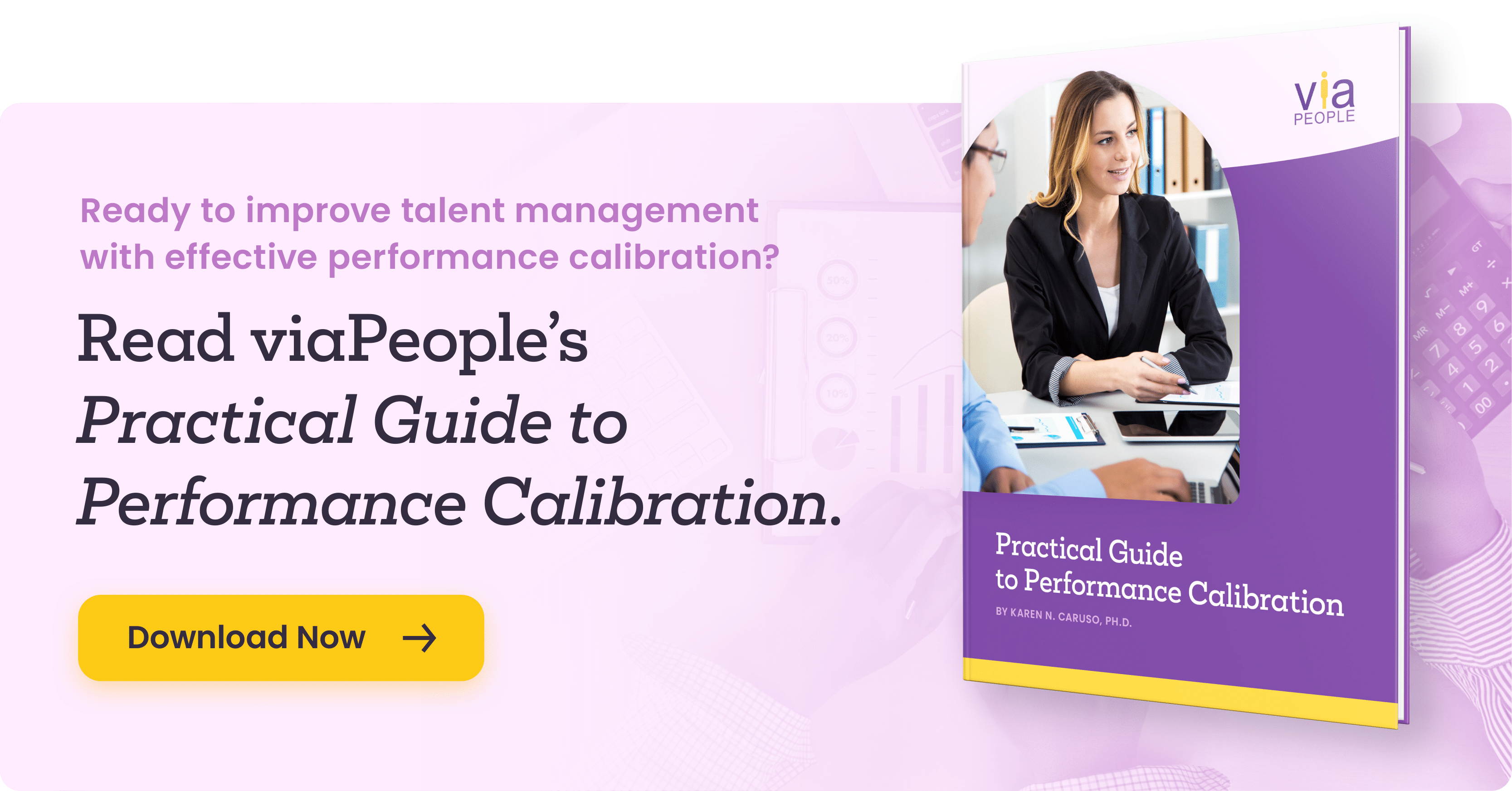3 Expert Tricks to Identify Poor Performance Calibration

Performance ratings are an important part of how you manage talent at your company.
The accuracy and usefulness of these ratings can be compromised, though, in cases of poor performance calibration. Your employees can also become distraught or even quit if they feel their performance reviews are unfair or inaccurate.
How do you know you have an organizational problem with performance calibration? We’ll look at three signs to look for and explain how to move forward.
What is performance calibration?
Performance calibration is the process of ensuring consistency in the standards and methodology behind rating performance across your organization. The goal is for all employees to receive performance reviews that are fair and accurate in relation to the way their colleagues are evaluated.
Every company has its own ways of measuring performance, and that’s perfectly alright. The key is for everyone within the company to be on the same page with how they measure performance, so employees know their ratings are based on objective criteria and not just the subjective opinions of their supervisors.
Achieving fair and accurate performance reviews is critical since 85 percent of employees would consider leaving their jobs if they received a performance review they felt was unfair.
The general steps involved in performance calibration include:
- Individual ratings: First, supervisors rate their direct reports to the best of their abilities. They don’t share these ratings with their employees just yet.
- Calibration meetings: Managers discuss their ratings with each other during a performance calibration meeting. Together with HR staff, supervisors weigh individual ratings against each other and against historical data to identify any outliers that may need to be corrected.
- Adjustments: If the meeting reveals an issue with any ratings being too high, too low, or otherwise off, the next step is to adjust the review as needed so it falls in line with consistent standards. Then, managers can share reviews with their direct reports.
What are 3 ways to identify poor performance calibration?
Let’s look in more detail at three ways you can identify potential issues in ratings during the performance calibration process.
If you’re not accustomed to calibrating performance reviews, then these steps can also help you identify a need for performance calibration in your company. For example, an HR department can undertake these steps on their own, and if they identify any red flags, they’ll know it’s time to get the whole organization involved in a performance calibration process.
1. Analyze aggregate distributions of ratings for departments.
One way to spot potential problems in performance calibration is to get a bird’s-eye view of ratings across departments or particular job functions. In other words, you’ll want to see how whole departments compare to one another.
Here’s how you can do that:
Find the average rating for each department.
Start by determining what each department’s average rating is based on all the individual ratings for the employees within that department. If you have numerical ratings for employees’ performance (either overall or for individual metrics, such as productivity, attitude, and so on), you can find averages mathematically.
For more qualitative rating systems, you may want to convert these ratings to numbers just for this step. For example, you may find that an unsatisfactory rating is a 1, sufficient performance is a 2, and exceeding expectations is a 3. Then you can find averages and convert back to nonnumerical labels if you wish.
Look for major differences between departments.
For example, you may find that the accounting department has a stellar average rating of “exceptional,” or 4.5 on a 5-point scale, while the sales team has an average rating of “below expectations,” or 1.75.
If there are major differences from one department to the next, consider why that may be.
Keep in mind that, while this can be a red flag, it doesn’t always point to inaccuracy. In some companies, one department may be legitimately exceptional while others are legitimately struggling. If the data doesn’t seem to reflect what you see in reality, though, it’s time to calibrate performance ratings to achieve better consistency.
2. Compare ratings given by individual managers.
Another way you may find inconsistencies in performance ratings is by comparing the way individual managers review employees. Some managers may need some additional instruction on how to review performance in order to align with the way other managers are reviewing performance.
Here’s how you can find possible issues with individual managers’ performance ratings:
Find ranges and averages for each manager.
For this process, it’s helpful to look at the average ratings managers give their direct reports as well as the range that their ratings fall within. For example, you may find that some managers’ ratings run the full gamut of the rating scale while others’ ratings fall within a tight window.
Compare managers’ ratings.
Once you’ve determined how each manager rates their employees, you can compare this data to see if any patterns or outliers emerge. For example, you may see that some managers seem to be too generous or too harsh with their ratings.
Consider possible causes for skewed reviews.
If you notice some managers’ reviews seem to be slanted, it could be due to a variety of factors. One issue is simply inexperience or poor skills in conducting performance appraisals. This is especially likely if a manager is new in their role and is rating employees’ performance for the first time. Another possibly related issue is if a manager misunderstands aspects of the rating scale or criteria they should use to review employees’ performance.
Another common reason has to do with a reviewer’s general attitude and personal biases. People’s perspectives tend to be quite subjective, which is why performance calibration is so critical. According to HR consultant Sharlyn Lauby, there are five common biases that can affect managers during performance reviews.
- Contrast bias: A manager may want to rank employees compared to each other, ensuring that some fall to the bottom and some rise to the top. This tendency can lead to some forced reviews that are inaccurately high or low.
- Halo bias: If an employee is exceptional in one area, a supervisor may want to rate them highly across the board even though they may need improvement in some areas.
- Horn bias: By the same token, a manager can give employees poor performance appraisals even for job duties they perform well in because they struggle in one area.
- Leniency bias: Managers who want to get through the performance review process quickly may be tempted to give all employees similar positive ratings rather than have to deal with addressing problems in performance.
- Recency bias: Rather than considering an employee’s performance across the performance period, a manager may give too much weight to a recent accomplishment or a recent failure that comes to mind, skewing the employee’s review.
These aren’t the only biases to be aware of. A manager may also engage in idiosyncratic rater bias, where they judge employees more harshly on skills where they personally excel and judge employees more leniently on skills they struggle with themselves.
Furthermore, managers may have personal prejudices or unconscious biases when it comes to employee demographics such as race, age, or gender. Performance calibration can minimize the influence of these harmful biases.
3. Look for individual outliers in employees’ performance ratings.
Finally, you should compare individual employees’ performance appraisals across your organization. Are there any employees who received a particularly high or low rating? If so, it’s worth looking into further to see whether the review is accurate.
You may find that outlier reviews are accurate. An employee may legitimately be an exceptional performer deserving of a promotion, or they may be underperforming, warranting a performance review plan or other interventions.
If an extreme performance review is inaccurate, it could be due to the issues we discussed above, including a reviewer’s biases, inexperience, or misunderstandings. Whatever the reason, a performance calibration process should address the issue so you can improve the accuracy of every employee’s performance review.
How should you proceed when you identify a performance calibration issue?
If you find some red flags that point to poor performance calibration, what should you do next? It’s time to address the issue. There are two main solutions we recommend.
One is to equip your organization with the right tools to empower successful performance reviews. Performance management software from viaPeople can facilitate the process of reviewing performance and can make it easier to record and access performance review data that you can use during performance calibration.
The other solution is to calibrate performance reviews across your organization so you can correct unfair or inaccurate reviews before they are shared with employees. Use our Practical Guide to Performance Calibration for a step-by-step guide to getting started with your performance calibration!
Share this
You May Also Like
These Related Stories

5 Ways to Take the 'Creep' Out of Employee Performance Ratings

Calibrate, Don't Force in Employee Performance Management

